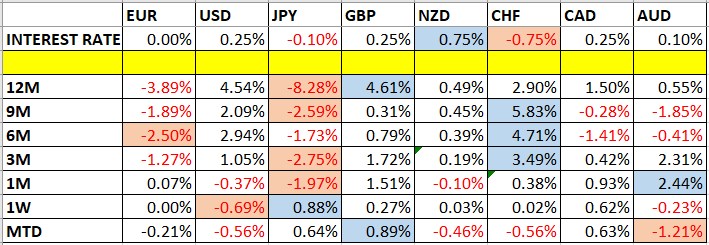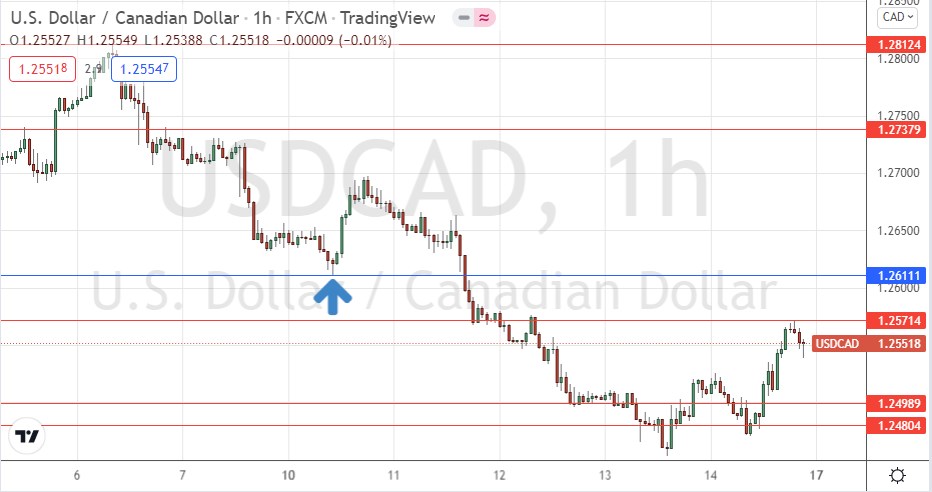This week I will begin with my monthly and weekly forecasts of the currency pairs worth watching. The first part of my forecast is based upon my research of the past 20 years of Forex prices, which show that the following methodologies have all produced profitable results:
- Trading the two currencies that are trending the most strongly over the past 6 months.
- Trading against very strong weekly counter-trend movements by currency pairs made during the previous week.
- Carry Trade: Buying currencies with high interest rates and selling currencies with low interest rates.
Let us look at the relevant data of currency price changes and interest rates to date, which we compiled using a trade-weighted index of the major global currencies:

Monthly Forecast January 2022
For the month of January, I made no forecast.
Weekly Forecast 16th January 2022
In my previous forecast last week, I made no weekly forecast, as there were no unusually strong counter-trend movements. Fading strong weekly counter-trend price movements is the basis of my weekly trading strategy.
I again make no weekly forecast, as there were no strong counter-trend price movements last week in the Forex market.
The Forex market saw a further decrease in its level of directional volatility last week, with only 4% of all the important currency pairs or crosses moving by more than 1% in value. Directional volatility is likely to increase slightly this week as markets seem to be firmly negative on the US dollar.
Last week was dominated by relative strength in the Japanese yen, and relative weakness in the US dollar.
You can trade our forecasts in a real or demo Forex brokerage account.
Key Support/Resistance Levels for Popular Pairs
I teach that trades should be entered and exited at or very close to key support and resistance levels. There are certain key support and resistance levels that can be watched on the more popular currency pairs this week.
Currency Pair | Key Support / Resistance Levels |
AUD/USD | Support: 0.7201, 0.7123, 0.7102, 0.7083 Resistance: 0.7223, 0.7293, 0.7321, 0.7344 |
EUR/USD | Support: 1.1394, 1.1352, 1.1261, 1.1250 Resistance: 1.1451, 1.1514, 1.1600, 1.1624 |
GBP/USD | Support: 1.3646, 1.3621, 1.3483, 1.3375 Resistance: 1.3769, 1.3852, 1.3898, 1.3950 |
USD/JPY | Support: 114.00, 113.07, 111.55, 111.23 Resistance: 114.39, 115.02, 116.00, 116.29 |
AUD/JPY | Support: 81.30, 81.05, 80.40, 79.81 Resistance: 83.00, 83.75, 84.35, 84.83 |
EUR/JPY | Support: 128.97, 128.53, 128.30, 127.44 Resistance: 130.42, 130.62, 130.84, 131.78 |
USD/CAD | Support: 1.2535, 1.2505, 1.2372, 1.2250 Resistance: 1.2611, 1.2738, 1.2812, 1.2901 |
USD/CHF | Support: 0.9117, 0.9072, 0.9000, 0.8969 Resistance: 0.9200, 0.9229, 0.9271, 0.9370 |
Let us see how trading reversals from one of last week’s key levels could have worked out:
USD/CAD
I had expected the level at 1.2611 might function as support, as it had acted previously as both support and resistance. Note how these “flipping” levels can work well. The H1 chart below shows how the price rejected this level with a pin bar soon after the start of last Monday’s London session, often a good time to enter a new trade in a major Forex currency pair involving the US Dollar, marked by the up arrow in the price chart below. This trade was nicely profitable, achieving a maximum positive reward to risk ratio of approximately 4 to 1 based upon the size of the entry candlestick.

That is all for this week. You can trade my forecasts in a real or demo Forex brokerage account to test the strategies and strengthen your self-confidence before investing real funds.

